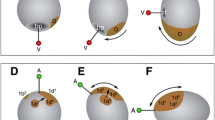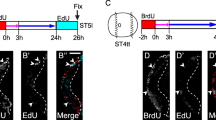Summary
The cell division pattern of the germ band of Cherax destructor is described from gastrulation to segmentation, limb bud formation, and early neurogenesis. The naupliar segments are formed almost simultaneously from scattered ectoderm cells arranged in a V-shaped germ disc, anterior to the blastopore. No specific cell division pattern is recognisable. The post-naupliar segments are formed successively from front to rear. Most post-naupliar material is budded by a ring of about 39 to 46 ectoteloblasts, which are differentiated successively and in situ in front of the telson ectoderm. The ectoteloblasts give rise to 15 descendant cell rows by unequal divisions in an anterior direction, following a mediolateral mitotic wave. Scattered blastoderm cells of non-ectoteloblastic origin in front of the ectoteloblast descendants and behind the mandibular region are also arranged in rows. Despite their different origins, teloblastic and non-teloblastic rows cleave twice by mediolateral mitotic waves to form 4 regular descendant rows each. Thereafter, the resulting grid-like pattern is dissolved by stereotyped differential cleavages. Neuroblasts are formed during these differential cleavages and segmentation becomes visible. Each ectoderm row represents a parasegmental unit. Therefore, the segmental boundary lies within the area covered by the descendants of 1 row. Segmental structures (limbs, ganglia) are composed of derivatives of 2 ectoderm rows. The results are compared with the early development of other crustaceans and insects in relation to mechanisms of germ band formation, segmentation, neurogenesis, and evolution.
Similar content being viewed by others
References
Ambros V (1988) Genetic basis for heterochronic variation. In: McKinney ML (ed) Heterochrony in evolution. Plenum Press, New York, 269–285
Bate CM (1976) Embryogenesis of an insect nervous system: I. A map of the thoracic and abdominal neuroblasts in Locusta migratoria. J Embryol Exp Morphol 35:107–123
Benesch R (1969) Zur Ontogenie und Morphologie von Artemia salina L. Zool Jb Anat 86:307–458
Celada JD, Carral JM, Gonzalez J (1991) A study on the identification and chronology of the embryonic stages of the freshwater crayfish Austropotamobius pallipes (Lereboullet, 1858). Crustaceana 61:225–232
Doe CQ, Goodman CS (1985a) Early events in insect neurogenesis I. Development and segmental differences in the pattern of neuronal precursor cells. Dev Biol 111:193–205
Doe CQ, Goodman CS (1985b) Early events in insect neurogenesis: II. The role of cell interactions and cell lineage in the determination of neuronal precursor cells. Dev Biol 111:206–219
Dohle W (1964) Die Embryonalentwicklung von Glomeris marginata (Villers) im Vergleich zur Entwicklung anderer Diplopoden. Zool Jb Anat 81:241–310
Dohle W (1970) Die Bildung und Differenzierung des postnauplialen Keimstreifs von Diastylis rathkei (Crustacea, Cumacea): 1. Die Bildung der Teloblasten und ihrer Derivate. Z Morphol Tiere 67:307–392
Dohle W (1972) Über die Bildung und Differenzierung des postnauplialen Keimstreifs von Leptochelia spec. (Crustacea, Tanaidacea). Zool Jb Anat 89:503–566
Dohle W (1976a) Die Bildung und Differenzierung des postnauplialen Keimstreifs von Diastylis rathkei (Crustacea, Cumacea): II. Die Differenzierung and Musterbildung des Ektoderms. Zoomorphologie 84:235–277
Dohle W (1976b) Zur Frage des Nachweises von Homologien durch die komplexen Zell- und Teilungsmuster in der embryonalen Entwicklung höherer Krebse (Crustacea, Malacostraca, Peracarida). Sitzber Ges Naturforsch Freunde Berlin (N.F.) 16/2: 125–144
Dohle W (1989) Zur Frage der Homologie ontogenetischer Muster. Zool Beitr (N.F.) 32:355–389
Dohle W, Scholtz G (1988) Clonal analysis of the crustacean segment: the discordance between genealogical and segmental borders. Development 104 (Suppl):147–160
Fioroni P (1969) Zum embryonalen und postembryonalen Dotterabbau des Flußkrebses (Astacus; Crustacea malacostraca, Decapoda). Rev Suisse Zool 76:919–946
Freeman JA (1989) Segment morphogenesis in Artemia larvae. In: Warner AH, MacRae TH, Bagshaw JC (eds) Cell and molecular biology of Artemia development. Plenum Press, New York, pp 77–90
Fulinski B (1908) Beiträge zur embryonalen Entwicklung des Fluß-krebses. Zool Anz 33:20–28
Gould SJ (1977) Ontogeny and phylogeny. Harvard University Press, Cambridge
Grobben (1879) Die Entwicklungsgeschichte der Moina rectirostris. Arb Zool Inst Wien 2:203–268
Hahnenkamp L (1974) Die Bildung und Differenzierung des Keimstreifens der Asseln (Isopoda) and anderer höherer Krebse. Eine vergleichend-embryologische Studie. Zulassungsarbeit für die I. (wissenschaftliche) Staatsprüfung, Abschnitt 11:1–179
Hartenstein V, Rudloff E, Campos-Ortega JA (1987) The pattern of proliferation of the neuroblasts in the wild-type embryo of Drosophila melanogaster. Roux's Arch Dev Biol 196:473–485
Henry JJ, Raff RA (1990) Evolutionary change in the process of dorsoventral axis determination in the direct developing sea urchin, Heliocidaris erythrogramma. Dev Biol 141:55–69
Heymons R (1901) Die Entwicklungsgeschichte der Scolopender. Zoologica 13:1–244
Krause G (1939) Die Eitypen der Insekten. Biol Zentralbl 59:495–536
Krause G (1987) Evolutionary shifts indicated by the time pattern of embryogenetic events in Pimpla (Hymenoptera) as compared with Tachycines (Orthoptera). Zool Jb Anat 116:453–472
Malzacher P (1968) Die Embryogenese des Gehirns paurometaboler Insekten. Untersuchungen an Carausius morosus und Periplaneta americana. Z Morphol Tiere 62:103–161
Mee J, French V (1986) Disruption of segmentation in a short germ insect embryo: 11. The structure of segmental abnormalities induced by heat shock. J Embryol Exp Morphol 96:267–294
Meinhardt H (1982) Models of biological pattern formation. Academic Press, London
Moritz M (1957) Zur Embryonalentwicklung der Phalangiiden (Opiliones, Palpatores) unter besonderer Berücksichtigung der äußeren Morphologie, der Bildung des Mitteldarmes und der Genitalanlage. Zool Jb Anat 76:331–370
Oishi S (1959) Studies on the teloblasts in the decapod embryo: I. Origin of teloblasts in Heptacarpus rectirostris STIMPSON. Embryologia 4:283–309
Oishi S (1960) Studies on the teloblasts in the decapod embryo: II. Origin of teloblasts in Pagurus samuelis STIMPSON and Hemigrapsus sanguineus DE HAAN. Embryologia 5:270–282
Patel NH, Kornberg TB, Goodman CS (1989) Expression of engrailed during segmentation in grasshopper and crayfish. Development 107:201–212
Reichenbach H (1888) Zur Embryonalentwicklung des Fluß-krebses. Abh Senckenberg Ges Nat Forsch 14:1–137
Sandeman R, Sandeman D (1991) Stages in the development of the embryo of the fresh-water crayfish Cherax destructor. Roux's Arch Dev Biol 200:27–37
Sander K (1983) The evolution of patterning mechanisms: gleanings from insect embryogenesis and spermatogenesis. In: Goodwin BC, Holder N, Wylie CG (eds) Development and evolution. Cambridge University Press, pp 137–159
Scholtz G (1984) Untersuchungen zur Bildung und Differenzierung des postnauplialen Keimstreifs von Neomysis integer LEACH (Crustacea, Malacostraca, Peracarida). Zool Jb Anat 112:295–349
Scholtz G (1986) Die Bildung des Keimstreifs der Amphipoda (Peracarida) — cin abgewandelter Modus innerhalb der Malacostraca (Crustacea). Verh Dtsch Zool Ges 79:190
Scholtz G (1990) The formation, differentiation and segmentation of the post-naupliar germ band of the amphipod Gammarus pulex L. (Crustacea, Malacostraca, Peracarida). Proc R Soc Lond B 239:163–211
Shiino SM (1950) Studies on the embryonic development of Panulirus japonicus (Von Siebold). J Fac Fish Pref Univ Mie-Tsu 1:1–168
Sieg J (1984) Neuere Erkenntnisse zum natürlichen System der Tanaidacea. Eine phylogenetische Studie. Zoologica 46:1–132
Sommer R, Tautz D (1991) Asynchronous mitotic domains during blastoderm formation in Musca domestica L. (Diptera). Roux's Arch Dev Biol 199:373–376
Tamarelle M, Haget A, Ressouches A (1985) Segregation, division, and early patterning of lateral thoracic neuroblasts in the embryos of Carausius morosus Br. (Phasmida: Lonchodidae). Int J Insect Morphol Embryol 14:307–317
Tear G, Bate CM, Martinez Arias A (1988) A phylogenetic interpretation of the patterns of gene expression in Drosophila embryos. Development 104 (Suppl):135–145
Technau GM, Becker T, Campos-Ortega JA (1988) Reversible commitment of neural and epidermal progenitor cells during embryogenesis of Drosophila melanogaster. Roux's Arch Dev Biol 197:413–418
Thomas JB, Bastiani MJ, Bate M, Goodman CS (1984) From grasshopper to Drosophila: a common plan for neuronal development. Nature 310:203–207
Tiegs OW (1940) The embryology and affinities of the Symphyla, based on a study of Hanseniella agilis. Q J Micr Sci 82:1–225
Weygoldt P (1960) Embryologische Untersuchungen an Ostrakoden: Die Entwicklung von Cyprideis litoralis (G.S. Brady) (Ostracoda, Podocopa, Cytheridae). Zool Jb Anat 78:369–426
Whitington PM, Meier T, King P (1991) Segmentation, neurogenesis and formation of early axonal pathways in the centipede Ethmostigmus rubripes (Brandt). Roux's Arch Dev Biol 199:349–363
Wray GA, Raff RA (1990) Novel origins of lineage founder cells in the direct developing sea urchin Heliocidaris erythrogramma. Dev Biol 141:41–54
Zehnder H (1934) Uber die Embryonalentwicklung des Fluß-krebses. Acta Zoologica 15:261–408
Zilch R (1974) Die Embryonalentwicklung von Thermosbaena mirabilis MONOD. (Crustacea, Malacostraca, Pancarida). Zool Jb Anat 93:462–576
Author information
Authors and Affiliations
Rights and permissions
About this article
Cite this article
Scholtz, G. Cell lineage studies in the crayfish Cherax destructor (Crustacea, Decapoda) : germ band formation, segmentation, and early neurogenesis. Roux's Arch Dev Biol 202, 36–48 (1992). https://doi.org/10.1007/BF00364595
Received:
Accepted:
Issue Date:
DOI: https://doi.org/10.1007/BF00364595




